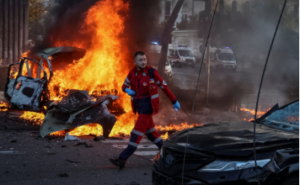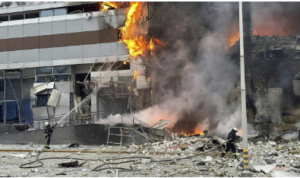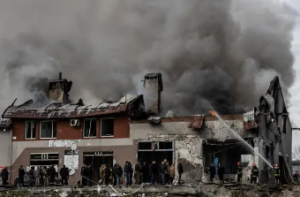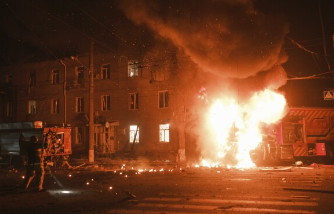In a dramatic escalation of conflict, Russia has launched another intense wave of strikes across Ukraine, marking the second consecutive day of significant bombardment. Early Tuesday, air raid alerts were issued nationwide as Ukrainian defenses detected Russian aircraft deploying hypersonic missiles. The attacks have resulted in widespread destruction, casualties, and disruptions to critical infrastructure.
Key Developments:
Widespread Attacks and Casualties: The latest round of Russian strikes has inflicted severe damage across several Ukrainian regions, including Kyiv, Lviv, Kharkiv, and Odesa. At least three people have been reported dead in the new wave of attacks. A civilian infrastructure building in Kryvyi Rih, the hometown of Ukrainian President Volodymyr Zelensky, was hit, leading to two fatalities and multiple missing persons. In Zaporizhzhia, one man was killed, and two others sustained injuries.
Targeting Infrastructure: Russia’s Ministry of Defense announced that long-range air and sea-based precision weapons were used to target Ukraine’s power stations and related infrastructure. This has led to widespread blackouts and disruptions in water supplies across affected cities, compounding the humanitarian crisis.

International Reactions: The attacks have drawn widespread condemnation from the international community. U.S. President Joe Biden denounced the strikes as “outrageous,” reaffirming the U.S.’s commitment to supporting Ukraine’s energy infrastructure. UK Foreign Secretary David Lammy also criticized Russia’s “cowardly missile and drone attacks on civilian infrastructure.”
Missile Launches and Regional Impact: The recent strikes included the launch of several Kinzhal ballistic missiles, known for their high speed and difficulty in interception. Explosions have been reported in various regions, including Kyiv, Sumy, Khmelnytsky, and Mykolayiv, adding to the devastation.
Context and Strategic Implications:
The recent escalation in attacks is viewed as Moscow’s effort to regain control following recent Ukrainian advances in Russia’s Kursk region. Since its full-scale invasion began in February 2022, Russia has consistently targeted Ukraine’s energy infrastructure. Recent months have seen a renewed focus on this strategy, leading to frequent power outages and further exacerbating the crisis.
Ukrainian President Zelensky has called on Western allies to revise their policies and permit Ukraine to utilize long-range weapons to strike deeper into Russian territory. Zelensky emphasizes that enhanced cooperation between European air forces and Ukraine’s air defense could significantly reduce civilian casualties.
As the conflict continues, the international community remains vigilant, assessing potential responses and additional support for Ukraine amidst ongoing Russian aggression.
By focusing on specific details like the impact of the strikes, international reactions, and the strategic context, this SEO-optimized article aims to provide a comprehensive update on the situation while engaging readers interested in current global events.

Detailed Overview of Recent Russian Strikes
Expanded Casualty and Damage Report
Casualty Figures and Injuries: In addition to the three confirmed deaths, several others are injured across different regions. In Kryvyi Rih, two people were killed in a civilian infrastructure attack, and search efforts are ongoing for missing individuals. The Zaporizhzhia attack resulted in one death and injuries to a man and a woman. Details on injuries and property damage in other affected areas, including Kyiv and Mykolayiv, highlight the widespread impact.
Impact on Critical Infrastructure: The strikes have severely damaged power stations, causing blackouts in major cities. Disruptions to water supplies have also been reported, affecting daily life and emergency services. The extent of infrastructure damage in each region could be detailed, including specific sites hit and the resulting outages.
Technical and Tactical Details
Types of Missiles Used: The Russian attacks included hypersonic Kinzhal missiles, which travel at speeds significantly faster than traditional missiles, making them difficult to intercept. Detailed information on the capabilities and impact of these missiles can provide insight into the challenges faced by Ukrainian defenses.
Drone and Missile Attack Patterns: Information on the frequency and patterns of the drone and missile attacks can illustrate the scale and coordination of the Russian offensive. Analysis of the specific regions targeted and the types of weapons used can offer a clearer picture of the strategic objectives behind the strikes.
Humanitarian Impact and Response
Displaced Persons and Humanitarian Efforts: The strikes have led to an increase in displaced persons within Ukraine. Details on the numbers of displaced individuals and the conditions they face, including temporary shelters and aid distribution, can highlight the humanitarian crisis.
Emergency Response and Aid: Information on the response efforts by Ukrainian emergency services, including the restoration of power and water supplies, can provide a sense of how the country is managing the immediate aftermath of the attacks. Contributions from international aid organizations and their role in supporting affected regions can also be included.
Political and Strategic Reactions
Ukrainian Government’s Response: Beyond President Zelensky’s calls for increased Western support, additional statements or actions by the Ukrainian government can be included. This might involve new strategies, appeals for international assistance, or changes in military tactics.
Western Allies’ Support: Details on specific forms of support being provided by Western allies, such as military aid, humanitarian assistance, or diplomatic efforts, can provide context for the international response to the crisis.

Russian Strategic Goals: Analysis of Russia’s potential strategic objectives behind the renewed attacks can be included. This might involve objectives related to territorial control, psychological impact, or disrupting Ukrainian military capabilities.





